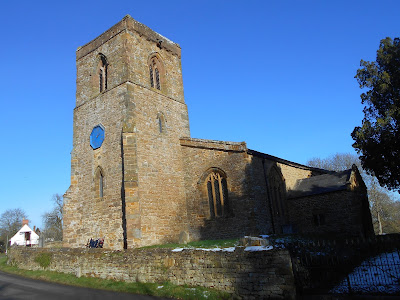 |
Crocus chrysanthus pushing through a patch of Sea Heath, Frankenia
laevis. Our garden on Stefen Hill, Daventry. 3 February, 2019
|
Welton proved to be a pretty village with just a couple of minor eyesores and I enjoyed a short walk around its streets, which form a figure-of-eight pattern. I investigated the local churchyard of course for, although I am deeply irreligious, 'God's Acre' usually proves to be of interest. The church is dedicated to St Martin and is believed to date back to the late 13th Century.
 |
| The Church of St Martin, Welton. 3 February, 2019 |
It is of simple rubblestone construction and although the stone is variable, perhaps from several quarries, it is clearly all Jurassic, in some cases of indifferent quality and eroding quite badly in places. Diana Sutherland (see reference) hints that the rock may be largely marlstone
Reference
Sutherland, D.L. (2003) Northamptonshire Stone Dovecote Press
 |
Some of the masonry had weathered rather badly, leading
to obvious erosion. Welton church, 3 February, 2019
|
I ought to have spent time examining the stonework for fossils but, despite the bright sunshine it was very cold, with a biting wind. For the same reason I made little effort to track down lichens.
 |
The lichen, Caloplaca flavescens can be very distinctive.
St Martin's Church, Welton. 3 February, 2019
|
A specimen of Caloplaca flavescens caught the eye but the only other species noted was the very common Psilolechia lucida, forming a dust-like sulphur yellow stain here and there.
 |
The powder-like green-yellow lichen, Psilolechia lucida.
Welton church, 3 February, 2019
|
I completed a circuit of the church, noting some good examples of yew and holm oak without making any sensational discoveries. But the margins of the village hinted at interesting walks and I'll probably be returning in the late spring or early summer.
 |
A less familiar view of St Martin's church, Welton.
3 February, 2019
|
Sutherland, D.L. (2003) Northamptonshire Stone Dovecote Press
No comments:
Post a Comment